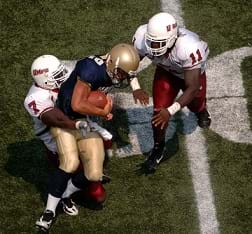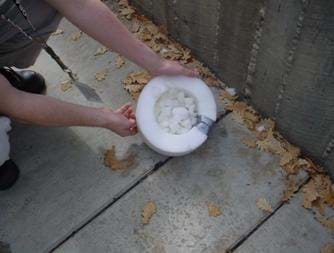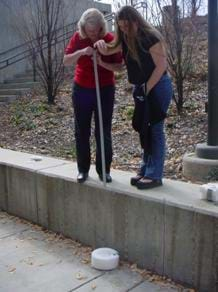Quick Look
Grade Level: 4 (3-5)
Time Required: 45 minutes
Expendable Cost/Group: US $2.00
Group Size: 2
Activity Dependency: None
Subject Areas: Physical Science, Science and Technology
NGSS Performance Expectations:

| 3-5-ETS1-1 |
| 3-5-ETS1-2 |
| 3-5-ETS1-3 |
Summary
Athletes often wear protective gear to keep themselves safe in contact sports. In this spirit, students follow the steps of engineering design process as they design, build and test protective padding for an egg drop. Many of the design considerations surrounding egg drops are similar to sports equipment design. Watching the transformation of energy from potential to kinetic, observing the impact and working under material constraints introduces students to "sports engineering" and gives them a chance to experience some of the challenges engineers face in designing equipment to protect athletes.
Engineering Connection
An egg is a delicate object. In certain sports such as football, rugby and lacrosse, humans are considered delicate, too! These sports sometimes present dangerous conditions that can be unsafe for humans. However, an acceptable level of safety can be accomplished by protecting athletes through good engineering design. Engineers who design sports equipment must consider energy impact and material constraints.
Learning Objectives
After this activity, students should be able to:
- Explain that engineers design protective equipment for athletes in many sports.
- Explain that engineers re-design, re-build and re-test before arriving at a final design.
Educational Standards
Each TeachEngineering lesson or activity is correlated to one or more K-12 science,
technology, engineering or math (STEM) educational standards.
All 100,000+ K-12 STEM standards covered in TeachEngineering are collected, maintained and packaged by the Achievement Standards Network (ASN),
a project of D2L (www.achievementstandards.org).
In the ASN, standards are hierarchically structured: first by source; e.g., by state; within source by type; e.g., science or mathematics;
within type by subtype, then by grade, etc.
Each TeachEngineering lesson or activity is correlated to one or more K-12 science, technology, engineering or math (STEM) educational standards.
All 100,000+ K-12 STEM standards covered in TeachEngineering are collected, maintained and packaged by the Achievement Standards Network (ASN), a project of D2L (www.achievementstandards.org).
In the ASN, standards are hierarchically structured: first by source; e.g., by state; within source by type; e.g., science or mathematics; within type by subtype, then by grade, etc.
NGSS: Next Generation Science Standards - Science
| NGSS Performance Expectation | ||
|---|---|---|
|
3-5-ETS1-1. Define a simple design problem reflecting a need or a want that includes specified criteria for success and constraints on materials, time, or cost. (Grades 3 - 5) Do you agree with this alignment? |
||
| Click to view other curriculum aligned to this Performance Expectation | ||
| This activity focuses on the following Three Dimensional Learning aspects of NGSS: | ||
| Science & Engineering Practices | Disciplinary Core Ideas | Crosscutting Concepts |
| Define a simple design problem that can be solved through the development of an object, tool, process, or system and includes several criteria for success and constraints on materials, time, or cost. Alignment agreement: | Possible solutions to a problem are limited by available materials and resources (constraints). The success of a designed solution is determined by considering the desired features of a solution (criteria). Different proposals for solutions can be compared on the basis of how well each one meets the specified criteria for success or how well each takes the constraints into account. Alignment agreement: | People's needs and wants change over time, as do their demands for new and improved technologies. Alignment agreement: |
| NGSS Performance Expectation | ||
|---|---|---|
|
3-5-ETS1-2. Generate and compare multiple possible solutions to a problem based on how well each is likely to meet the criteria and constraints of the problem. (Grades 3 - 5) Do you agree with this alignment? |
||
| Click to view other curriculum aligned to this Performance Expectation | ||
| This activity focuses on the following Three Dimensional Learning aspects of NGSS: | ||
| Science & Engineering Practices | Disciplinary Core Ideas | Crosscutting Concepts |
| Generate and compare multiple solutions to a problem based on how well they meet the criteria and constraints of the design problem. Alignment agreement: | Research on a problem should be carried out before beginning to design a solution. Testing a solution involves investigating how well it performs under a range of likely conditions. Alignment agreement: At whatever stage, communicating with peers about proposed solutions is an important part of the design process, and shared ideas can lead to improved designs.Alignment agreement: | Engineers improve existing technologies or develop new ones to increase their benefits, to decrease known risks, and to meet societal demands. Alignment agreement: |
| NGSS Performance Expectation | ||
|---|---|---|
|
3-5-ETS1-3. Plan and carry out fair tests in which variables are controlled and failure points are considered to identify aspects of a model or prototype that can be improved. (Grades 3 - 5) Do you agree with this alignment? |
||
| Click to view other curriculum aligned to this Performance Expectation | ||
| This activity focuses on the following Three Dimensional Learning aspects of NGSS: | ||
| Science & Engineering Practices | Disciplinary Core Ideas | Crosscutting Concepts |
| Plan and conduct an investigation collaboratively to produce data to serve as the basis for evidence, using fair tests in which variables are controlled and the number of trials considered. Alignment agreement: | Tests are often designed to identify failure points or difficulties, which suggest the elements of the design that need to be improved. Alignment agreement: Different solutions need to be tested in order to determine which of them best solves the problem, given the criteria and the constraints.Alignment agreement: | |
International Technology and Engineering Educators Association - Technology
-
Students will develop an understanding of the attributes of design.
(Grades
K -
12)
More Details
Do you agree with this alignment?
-
Students will develop an understanding of engineering design.
(Grades
K -
12)
More Details
Do you agree with this alignment?
-
Models are used to communicate and test design ideas and processes.
(Grades
3 -
5)
More Details
Do you agree with this alignment?
-
Apply the technology and engineering design process.
(Grades
3 -
5)
More Details
Do you agree with this alignment?
-
Evaluate designs based on criteria, constraints, and standards.
(Grades
3 -
5)
More Details
Do you agree with this alignment?
State Standards
Colorado - Math
-
Measure the length of an object by selecting and using appropriate tools such as rulers, yardsticks, meter sticks, and measuring tapes.
(Grade
2)
More Details
Do you agree with this alignment?
Colorado - Science
-
Identify and describe the variety of energy sources
(Grade
4)
More Details
Do you agree with this alignment?
Materials List
Each group needs:
- 1 raw egg
For the entire class to share:
- foam
- duct tape
- masking tape
- white paper
- colored pencils/crayons
Worksheets and Attachments
Visit [www.teachengineering.org/activities/view/cub_intro_lesson04_activity1] to print or download.Pre-Req Knowledge
By engaging in the science and engineering practices of defining problems, developing and using models and designing solutions, students make sense of energy concepts used by engineers to design sporting equipment. Students explore the disciplinary core concept of engineering design while applying the crosscutting concept of system models.
Introduction/Motivation
Do you like to watch sports, either live or on TV? Do you participate in any sports or maybe more than one type of sport? Do you wear any gear when playing your favorite sport? Is the gear or equipment you use needed to play the game or for protecting the players? Many engineers design equipment for the purpose of keeping athletes safe. Let's brainstorm some different types of protective gear that engineers create. (Listen to student ideas.) Helmets, pads, mouth-guards, shin guards all all worn by players for protection. Can you think of other Olympic sports that require protective gear?
Can you think of other Olympics sports that require protective gear? (Listen to student ideas.) What about: kayaking (life vests), cycling (helmets, gloves, sunglasses), fencing (masks, padding), gymnastics (floor mats), and ice hockey (gloves, padding)? The activity that we are doing today mimics the concept of engineering protective gear for athletes. You will work as an engineer to keep your athlete (in this case, an egg) safe during an impact.
Imagine that you are up high in a tree and are holding a bowling ball. As you sit on a branch holding the ball, you wonder if the ball has kinetic or potential energy. Well, the ball has no kinetic energy as it lies between your hands, since it is not moving, but it does have potential energy, since it is above the ground. Then you release the ball and let it fall to the ground. As the ball falls, it has both kinetic and potential energy. Once it hits the ground, it no longer has potential energy. All the potential energy was converted to kinetic energy during the fall. After the ball stops moving, it will not have any energy left at all because all of the energy has been absorbed by the ground.
For this activity, we will drop an egg from a height of two meters (~6.5 ft)! By the time the egg hits the ground, it will be traveling very fast and will hit the landing pad with a lot of force. Your job is to engineer a landing pad to absorb the energy so that the egg does not break upon impact. Without the protective landing pad that you make, the egg would most surely break from the impact of the fall.
Do you think that engineers usually build the very first design that they think of after a design session? If you answered no, you are right, as they almost never do! Usually, engineers test many, many different designs before they arrive at very best one that meets the requirements for the situation and is ready to be replicated many times over. When engineers try again and re-design, re-build and re-test, that process is called "iteration." Engineers typically iterate many times before achieving a final solution to a problem. Today, your first design may not work; however, that is okay, because just like a real engineer, you get to try again with a new and improved design!
Procedure
Before the Activity
- Gather supplies. Make sure to have plenty of tape available for student use.
- Cut foam into 1 m x .5 m x 3 cm pieces.
With the Students
- Review the concept of kinetic and potential energy, and explain how it applies to the egg drop challenge. Draw a diagram of the egg dropping and have students identify which type of energy(ies) the egg has throughout the process. (Answer: Potential when resting above the ground, potential and kinetic when falling, none when still on the ground, as all of the energy would be absorbed by the landing pad.)
- Give the students the following engineering requirements and constraints for their landing pads. Refer to Figure 1 for example landing pad.

- The landing pad must be between 15 and 30 cm wide.
- The landing pad may be no more than 6 cm tall.
- You have only 5 minutes to design the pad; it must be drawn on a piece of paper.
- You get 15 minutes to build your designs.
- Divide the class into groups of two students each.
- Give student pairs 5 minutes to design and sketch their landing pads.
- Have each group show its design to the teacher, who checks to make sure it meets the design requirements.
- After designs are approved, give students 15 minutes to build their landing pads. Keep teams on track during building so they do not run out of time to test.
- Once all groups are ready, begin testing. Measure a height of 2 meters (~6.5 ft.) above the ground and make sure all eggs are dropped from the same height. (See Troubleshooting Tips for hints on dropping the eggs.) Set up the testing area outside, or over a tarp or thick layer of newspaper inside. Direct one group at a time to test while the others observe.

- Once all groups have tested, those with unbroken eggs may test again, but from a higher higher distance (try 2.5 meters, or 8.2 ft). Keep raising the drop height if the eggs remain intact.
- When all eggs (or most, if time is limited) have broken, give groups a chance to re-design, re-build and re-test their landing pads. Talk with them about the importance of iteration and how practicing engineers often go through many cycles of design and testing before successful final designs are achieved.
- After the second iteration of landing pads has been tested, give the students time (one to two minutes) to present their new designs to the class. Encourage students to think about and discuss which designs worked best, and why. Which design features helped protect the eggs the best?
Vocabulary/Definitions
iterate: To do something again and again and again.
iteration: Repeating a series of steps to get closer to a desired outcome (that is, re-design, re-test, re-build to get closer to the optimal engineering solution to a specific problem); can also refer to a version of the final product or solution.
Assessment
Pre-Activity Assessment
Brainstorming: In small groups, have students engage in open discussion. Remind students that no idea or suggestion is "silly." All ideas should be respectfully heard. Ask:
- What kinds of sports use padding to protect athletes?
- What do you think are some of the challenges that engineers face in trying to keep athletes safe?
Activity Embedded Assessment
Re-Design Practice: Give students time to re-design, re-build and re-test their landing pads. This is a great way to explain how engineers typically go through many, many iterations of their designs before an optimal design is achieved.
Post-Activity Assessment
Informal Discussion: Solicit, integrate and summarize student responses. Ask students which parts of their designs worked well, what did not work and what they think they could change to make their designs better.
Making Sense: Have students reflect about the science phenomena they explored and/or the science and engineering skills they used by completing the Making Sense Assessment.
Safety Issues
- Remind students to use caution if standing on tables or chairs; in their excitement, they may accidentally tip over the chair/desk and fall.
- If students' eggs have broken, be sure to have them clean up and wash their hands with soap.
Troubleshooting Tips
One challenging aspect of the activity is ensuring that eggs fall straight down when dropped. One solution is to drop the egg through some kind of tube, such as a piece of PVC pipe or a cardboard tube.
If conducting this activity as part of the Olympic Engineering unit, lead students to think about Olympic events that require protective gear.
Activity Extensions
Have students research companies that design protective gear for athletes. Contact a company to ask what kind of engineers work there and what sort of design work they focus on during their day-to-day activities. Try to speak with engineers who design protective gear, and see if they can visit the class or send emails with descriptions of their work lives.
Activity Scaling
- For lower grades, set the height of the drop lower and give students more materials.
- For older grades, set the height of the drop higher and give students fewer materials. Also, assign students to complete the Energy Worksheet, available as an attachment to the associated lesson.
Subscribe
Get the inside scoop on all things TeachEngineering such as new site features, curriculum updates, video releases, and more by signing up for our newsletter!More Curriculum Like This

Imagining themselves arriving at the Olympics gold medal soccer game in Rio, Brazil, students begin to think about how engineering is involved in sports. After a discussion of kinetic and potential energy, an associated hands-on activity gives students an opportunity to explore energy-absorbing mate...
Copyright
© 2006 by Regents of the University of ColoradoContributors
Connor Lowrey; Melissa Straten; Katherine Beggs; Denali Lander; Abigail Watrous; Janet YowellSupporting Program
Integrated Teaching and Learning Program and Laboratory, College of Engineering, University of Colorado BoulderAcknowledgements
The contents of this digital library curriculum were developed under grants from the Fund for the Improvement of Postsecondary Education (FIPSE), U.S. Department of Education, and the National Science Foundation (GK-12 grant no 0338326). However, these contents do not necessarily represent the policies of the Department of Education or National Science Foundation, and you should not assume endorsement by the federal government.
Last modified: October 20, 2020







User Comments & Tips